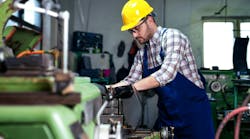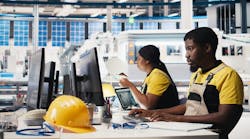Optimism Surfaces From Several Corners of the Industrial World
Last Friday’s jobs report cast a pall over many economists’ outlooks for the next few months and more. The consensus now has it that the low July reading and significant revisions to previous months’ data mean the economy is stalling at best or already tottering into recession.
Slack consumer spending, hamstrung by concerns about the labor market and tariff-induced inflation, is seen by many observers as playing a key role in that trend. However, the second-quarter earnings season that’s winding down has provided some hope that the goods-producing part of the U.S. economy is prepared to pick up some of the slack. Looking beyond Wall Street analysts’ earnings estimates (which are broadly rising after being slashed during the spring’s tariff turmoil) to what various executives have been saying, there’s an argument to be made that significant parts of industrial America looks to be in solid shape—and lining up to strengthen heading into 2026.
Without being Pollyannish, here are some excerpts from recent conference calls that are more hopeful than the general discourse has turned in recent days:
- Steve Laxton, CFO of steel manufacturer Nucor Corp., said the company’s sales teams are seeing “robust quoting activity and believe this reflects improved business confidence among our customers servicing the construction and infrastructure markets.” A few data points: Nucor’s backlog at its steel mills is up nearly 30% from a year ago and its backlog for sheet metal products is 15% higher year over year. Executives see second-half demand being stronger than last year and orders for the beams that go into data centers—the first of several mentions of those facilities here—are up “significantly” and expected to lead to “incremental demand for a variety of downstream products” in coming quarters.
- At Caterpillar Inc., recently named CEO Joe Creed told investors he is “increasingly optimistic about the top-line expectations” after a quarter in which the equipment giant’s orders and backlog both grew. Helping drive volumes is that a growing number of projects funded by the Infrastructure Investment and Jobs Act are—some would say “finally”—making their way into the market. CFO Andrew Bonfield said his team now expects second-half sales to grow more than they typically do for Cat.
- Joe Cutillo, president and CEO of Sterling Infrastructure Inc., told investors his teams expect to see strong demand from data centers for several years and are seeing steady activity in manufacturing with the promise of more megaprojects kicking off soon. Already strengthening, Cutillo said, is Sterling’s e-commerce book: “We have built a sizable level of backlog and believe we could see additional awards in the back half of the year. Together, these dynamics support strong growth opportunities over a multi-year period.” Sterling’s total backlog topped $2 billion as of June 30 versus $1.7 billion at the end of last year.
- The team at Olympic Steel Inc. is seeing momentum building in two of its divisions. President and COO Andrew Greiff said on the company’s Aug. 1 conference call that executives expect better second-half demand for pipes and tubes destined for data centers. In addition, he said, “Business conditions for both stainless and aluminum products began to improve during the second quarter.” A big factor there: The doubling of Section 232 tariffs on steel and aluminum to 50%.
To be extra clear: These upbeat sentiments were by no means universal. Multiple companies’ conference call transcripts have featured phrases such as the tepid “relatively resilient” or the more euphemistic “challenged.” And a handful of well-known economic indicators, including the ISM Manufacturing PMI don’t look great.
But there were enough versions of positive commentary on recent earnings calls to be noteworthy and to suggest that capital spending—and the many jobs it sustains across the country—isn’t about to fall off a cliff.
The red-hot data center sector is playing a big role but won’t be the only driver—see IIJA work gathering momentum now that more projects are out of the design and permitting phases. Olympic Steel CEO Rick Marabito said the bonus depreciation provisions included in the One Big Beautiful Bill Act are going to help spur customers to place orders they might otherwise have delayed a few more months. On top of that, he said, the expected drop in interest rates will generate more investment.
“Those two things, I think, will be a pretty powerful boost to demand,” Marabito said. “We’ve got part of the equation in place but the bigger part is really the interest rates.”
About the Author
Geert De Lombaerde
Senior Editor
A native of Belgium, Geert De Lombaerde has been in business journalism since the mid-1990s and writes about public companies, markets and economic trends for Endeavor Business Media publications, focusing on IndustryWeek, FleetOwner, Oil & Gas Journal, T&D World and Healthcare Innovation. He also curates the twice-monthly Market Moves Strategy newsletter that showcases Endeavor stories on strategy, leadership and investment and contributes to other Market Moves newsletters.
With a degree in journalism from the University of Missouri, he began his reporting career at the Business Courier in Cincinnati in 1997, initially covering retail and the courts before shifting to banking, insurance and investing. He later was managing editor and editor of the Nashville Business Journal before being named editor of the Nashville Post in early 2008. He led a team that helped grow the Post's online traffic more than fivefold before joining Endeavor in September 2021.



